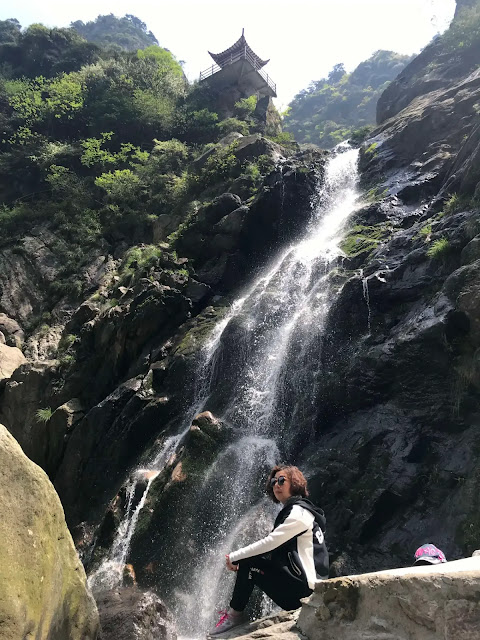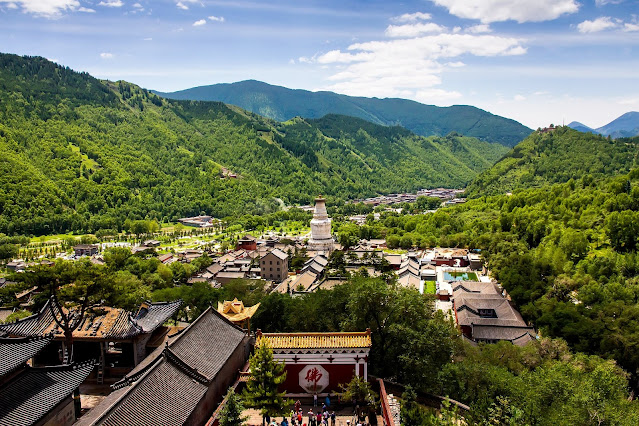Mountains in China
Mount Tai
Mount Tai, located in the central part of Tai'an City, Shandong Province, is a famous tourist attraction both at home and abroat. It is known as "the first mountain in the five mountains" and "the first mountain in the world".
The main peak of Mount Tai, Yuhuangding, is 1545 meters above sea level, with grand and magnificent views. Mount Tai has four unique marvelous wonders: the rising sun at dawn, the jade plate of sea of clouds, the aura appeaning around Bixia Temple, and rosy clouds at sunset. Mount Tai is well known for its spectacular, grandness, elevtion, width, steadiness and massiness. There are various picturesque views like craggy cliffs, deep canyons, grotesque peaks, odd rocks, luxuriant vegetation, flowing springs and twittering birds. Since ancient times, Mount Tai has been regarded as a sacred moutain. It has been said that "If Mount Tai is stable, so is the entire country". Over the past four thousand years, more than a dozen emperors have paid homage to Mount Tai, forming the unique mountain worship culture (Feng Shan), or emperor culture. The emperors, poets and scholars of every era left behind a large number of poems and stone inscriptions. There are 1696 stone inscriptions on Mount Tai, which are divided into cliff inscriptions and stele inscriptions. There are also many ancient trees on Mount Tai, such as pine trees in the Qin Dynasty, cypress trees in the Han Dynasty (about 1800 years ago) and locust trees in the Tang Dynasty (about 1200 years ago). These natural and human landscapes are integrated into one, which make Mount Tai extremely appealing.
Mount Tai is one of the first demonstration sites of China's civilized scenic spots and China's national 5A scenic spots. At the same time, Mount Tai also boasts another three titles: World Cultural Heritage, World Natural Heritage and World Geopark.
Mount Hua
Mount Hua, the West Moutain of the five sacred mountains,is located in Huayin City, Shaanxi Province, 120 kilometers east of the provincial capitalof Xi'an. It is connected to the Qinlinng Moutain in the south and overlooksthe Yellow River and the Weihe Plain in the morth.
Mount Hua is one of the first batch of national key scenic spots and China's national 5A tourist attractions.
Mount Emei
Mount Emei (Emei Shan), siting at the south-western rim of the Sichuan Basin, China, belongs to the Four Sacred Buddhist mountains in China besides Wutai Mountain in Shanxi, Mount Putuo in Zhejiang and Mount Jiuhua in Anhui. It enjoys a high reputation of "World-renowned Beauty of Mount Emei".
The whole Mount Emei consists of four large mountains with the highest altitude of 3,099 meters above the sea level at the Wan Fo Peak. There are four great natural miracles on the mountain: sunrise, a sea of clouds, the Buddha's halo and the vigil light. Mount Emei is located in the area where many natural elements converge. There is a great variety of vegetation,ranging from subtropical evergreen plants to subalpine pine forests. The vegetation coverage rate is over 87%. Mount Emei is also the habitat of many rare animals, with some 2,300 species recorded , including several threatened species at a global scale. Mount Emei is traditionally regarded as the bodhimanda, or place of enlightenment of the bodhisattva Samantabhadra. Samantabhadra is known in Mandarin as Puxian Pusa. Buddhist culture constitutes the main body of Mount Emei's history and culture. All the buildings, statues, artifacts, rituals, music and paintings create a marked atmosphere of religious culture. One of the most famous is Leshan Giant Buddha, which was carved in the 8th century out of the hillside. It is the tallest Buddha sculpture in the world with a height of 71 meters.
Huangshan
Huangshan, located in the southern part of Anhui Province, is one of the top ten famous mountains in China. It is said that "Trips to China's five great mountains render trips to other mountains unnecessary and a trip to Huangshan renders the trips to the five great mountains unnecessary."
Huangshan has 72 peaks, the three tallest and best-known of which are Lotus Peak (Lianhua Feng, 1,864m), Bright Peak (Guangming Ding, 1,860m), and Celestial Peak (Tiandu Feng, literally Capital of Heaven Peak, 1,829m). The highlights in Huangshan are "four wonders and three waterfalls". The famed four wonders are four unique views belonging to Huangshan, namely Strange Pines, Absurd Stones, A Sea of Clouds and Hot Springs respectively. The three imposing waterfalls are the Jiulong Waterfall (Nine-dragon Waterfall), the Renzi Waterfall, and the Baizhang Waterfall. The distinguished Guest-Greeting Pine is the landmark landscape of Huangshan, and also one of the symbols of Anhui Province. It has become a symbol of peace and friendship between China and the people of the world. In addition, Huangshan is still a treasure house of art. Huangshan has always been the subject of traditional painting, literature and modern photography. From the Tang Dynasty (618-907) to the end of the Qing Dynasty (1636-1912), there were more than 20,000 poems depicting Huangshan and a painting school named Huangshan. Currently, Huangshan National Park covers an area of 160.6 square kilometers with beautiful scenery, abundant resources and a wide variety of zoological species.
Huangshan is the symbol of Anhui tourism and is a national 5A tourist attraction in China. It is also listed as a double heritage of nature and culture in the world.
Lushan
Lushan, located in Jiujiang City, Jiangxi Province, is one of the ten famous mountains in China with its magnificence, steepness and beauty.
The oval-shaped mountains are about 25km long and 10km wide, and are adjacent to the Yangtze River to the north, Nanchang City to the south, and the Poyang Lake to the east. Its highest point is Dahanyang Peak, which reaches 1,474m above sea level, and is one of the hundreds of steep peaks that towers over a sea of clouds encompassing the mountains for almost 200 days out of the year. Additionally, Lushan is famous as a perfect summer resort as the weather there is rather cool especially during the summer. Lushan is an outstanding representative of Chinese landscape culture, with such beautiful verses "Its torrent dashes down three thousand feet from high; as if the Silver River fell from azure sky." The Flower Path in the west of the mountain also provided inspiration for Bai Juyi, a famous poet in the Tang Dynasty, who wrote the famous Peach Blossoms in Dalin Temple. Lushan also occupies an important position in Chinese history and culture. Lushan is a model of academic education in China, the most representative of which is Bailudong Academy, known as "the First Academy in China", where Zhu Xi, a noted scholar of the ong Dynasty, taught Confucianism in person.Besides, Lushan is also the birthplace of the world-famous Lushan tea.
Wryishan
Wryishan, located in the northwest of Fujian Province and near the border with Jiangxi Province, is a famous scenic spot and summer resort in China.
Wryishan has unique natural scenery, which is known overseas as "Danxia Landform". The highest peak in the area is Mount Huanggang at 2,158 meters. The landscape of Wryishan is characterized by beautiful winding river valleys flanked by columnar or dome-shaped cliffs as well as cave systems. Wryishan is the largest and most representative example of Chinese subtropical forests and the biodiversity of south China. Being an enormously important sanctuary for biodiversity conservation, Wryishan acts as a refuge for a large number of ancient, relict species,many of which endemic to China, and contains an extremely rich flora and fauna, including significant numbers of reptile, amphibian and insect species. Besides, Wryishan, also has a long history of tea cultivation, where oolong and black teas are produced. In history, Wryishan used to be an important center of Taoism and Buddhism, with numerous temples and monasteries, many now in ruins. In the 1st century B.C., a large administrative capital was built in and around Chengcun by the rulers of the Han Dynasty. Its massive walls enclose an archaeological site of great significance.
Wutai Mountain
The beautiful scenery in Wutai Mountain is a masterpiece of nature, predominantly visible over the five main peaks: Wanghai Peak in the east, Guayue Peak in the west, Jinxiu Peak in the south, Yedou Peak in the north, and the central Cuiyan Peak. Besides, Wutai Mountain is resplendent in many resources. Over 600 species of plants can be found, of which more than 150 species of grass can be used as rare herbs. Since the mountain is largely cold all year round, and even in midsummer days it remains cool, Wutai Mountain is also known as the Cool Mountain, the best of China's top 10 summer resorts.
Mount Qomolangma
Mount Qomolangma, the main peak of the Himalayas, is the highest mountain on earth with an altitude of 8,844.43 metres. Mount Qomolangma is located at the border between China and Nepal, with the north slope in the Tibet Autonomous Region, China, and the south slope in Sagarmatha Zone, Nepal. Qomolangma means "Mother Goddess of the Earth" in Tibetan. Mount Qomolangma is covered with huge glaciers that dissect the mountain into a huge pyramid with three massive faces and three major ridges on the north, south, and west sides of the mountain.Mount Qomolangma has an extreme climate. The summit temperature never rises above freezing. Its summit temperature in the coldest month of January averages -36°C and can drop as low as -60°C. In July, the warmest month, the average summit temperature is -19°C.
The highest mountain in the world attracts climbers with different capabilities, from well experienced mountaineers to novice climbers. Sir Edmund Hillary from New Zealand and Tenzing Norgay from Nepal were the first people ever to climb Mount Qomolangma in 1953. Men from several different countries climbed it after that. The difficulties of climbing Mount Qomolangma are well-known, such as altitude sickness, hurricane-force winds, massive snow, ice avalanches etc. The best season to visit the mountain is from May to October.





























No comments